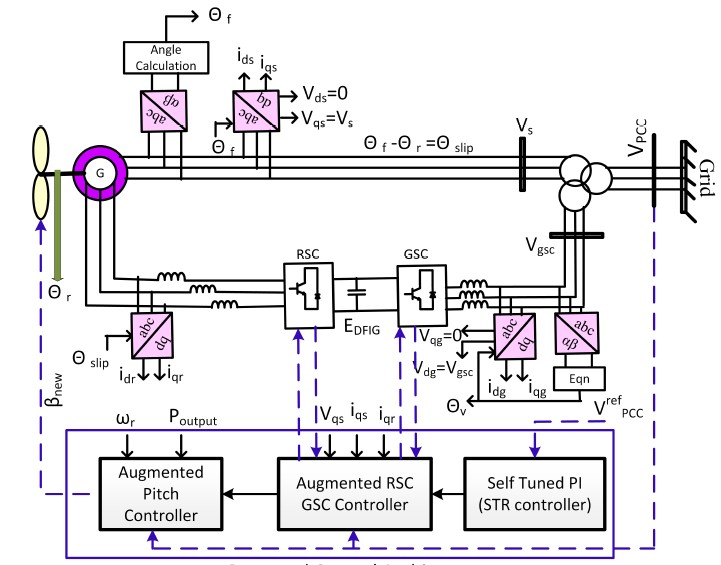A Dynamic Coordination Control Architecture for Reactive Power Capability Enhancement of the DFIG-based Wind Power Generation
Objective
The main objective of this project is to enhance the reactive power capability of wind power plants (WPPs) which deploy doubly-fed induction generator based wind turbines (DFIG-WTs).
Abstract
In this project, dynamic coordination control strategy is used to enhance the reactive power capability of Wind Power Plants (WPPs) which deploy Doubly-Fed Induction Generator Based Wind Turbines (DFIG-WTs). The proposed control architecture seeks to maximize reactive power availability during grid faults without violating the stable and thermal operational limits of the generator. The proposed control topology calculates the maximum available reactive power that can be provided by the DFIG-based WPP under any disturbed operation of a power system.
The reference value of the required reactive power compensation is there after calculated using an adaptive Proportional-Integral (PI) regulator which out performs the traditional PI controller. The computed reference value is directly applied to the outer control of the Rotor Side Converter (RSC) to regulate reactive power generation of the stator circuit. Furthermore, the P -V droop characteristics of the induction generator is employed to adjust the active power reference of the RSC converter to increase the reactive power capability during grid faults.
Meanwhile, de-rating the active power generation of the DFIG-based WT is accompanied with modifying the pitch angle of the rotor blades to balance the mechanical and electromagnetic torques and to avoid any stresses excreted on the mechanical parts of the WT. If rotor current limits are reached and more reactive power support is still required, the responsible control loop of the Grid Side Converter (GSC) will be activated and augmented to enhance the overall reactive power capability of the DFIG-based WPP. Finally, the proposed control strategy is verified using Two area four machines test systems using MATLAB/SIMULINK software.
Keywords: Doubly-fed induction generator (DFIG), Reactive Power Identification, Transient voltage adaptive controller, Wind Power Plants.
NOTE: Without the concern of our team, please don't submit to the college. This Abstract varies based on student requirements.
Block Diagram

Specifications
Software Configuration:
Operating System : Windows 7/8/10
Application Software : Matlab/Simulink
Hardware Configuration:
RAM : 8 GB / 4 GB (Min)
Processor : I3 / I5(Mostly prefer)
Learning Outcomes
- Introduction to Matlab/Simulink
- What is EISPACK & LINPACK
- How to start with MATLAB
- About Matlab language
- About tools & libraries
- Application of Matlab/Simulink
- About Matlab desktop
- Features of Matlab/Simulink
- Basics on Matlab/Simulink
- Introduction to wind power generation.
- Introduction to MPPT controllers.
- Design of power converters.
- Design of Voltage source converter.
- Design of MPPT controller.
- Design o PLL.
- Design of wind turbine.
- Design of DFIG.
- We can learn about the generation of gate pulses to the converter.
- We can learn about different types of PWM techniques .
- Introduction to controllers.
- Design of PI controller.
- Introduction to open loop and closed loop control system.
- We can learn about the Clarke’s transformation.
- We can learn about the park’s transformation.
- Project Development Skills:
- Problem analyzing skills
- Problem solving skills
- Creativity and imaginary skills
- Programming skills
- Deployment
- Testing skills
- Debugging skills
- Project presentation skills
- Thesis writing skills





 Paper Publishing
Paper Publishing
